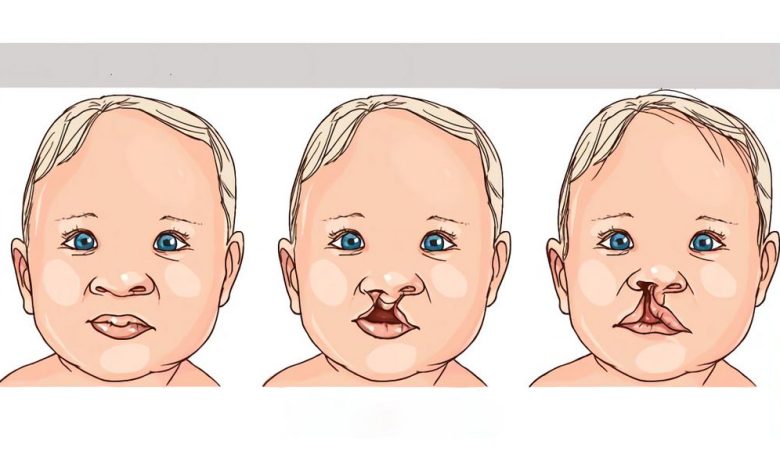Oral-facial cleft – cleft lip, cleft palate: What's it, symptoms, diagnostics, treatment, prevention

Oral-Facial Clefts (Cleft Lip; Cleft Palate)
Description of the oral-facial clefts
Oral-facial cleft – birth defect. It arises, when the lip or palate are not formed properly. The defect may include cleft lip, cleft palate or both defect. Cleft lip – interval in the upper lip, usually just below the nose. Cleft palate – slit in the sky or in the soft tissue of the mouth on top. In most cases, a cleft lip and cleft palate occur together.
The causes of oral-facial clefts
In the early stages of pregnancy, all children have an opening in the lip and palate. As the baby grows in the womb, these holes being overrun. At birth, the hole must be closed. For some reason, in children with oral-facial cleft, these holes do not overgrow. The exact reason for this is not known yet.
Risk factors for oral-facial clefts
Factors, which can increase the risk of oral-facial clefts include:
- The presence of other birth defects;
- Paul: male;
- The presence of a brother, a parent or other close relative with the oral-facial cleft;
- The best way to determine the actual risk, which can vary greatly in different families can geneticist;
- In general, if one child in a family has a cleft palate, there is 4% probability, that the next child would be born as a cleft palate. If there is a cleft lip only, risk, that it will have a second child is about 2%.
Factors in the mother during pregnancy, which can increase the risk of oral and maxillofacial cleft:
- Taking certain medications, such as anticonvulsants (especially phenytoin), thalidomide or retinoevaya Chisloth (used to treat dermatological diseases, such as acne);
- Smoking;
- Alcohol consumption (associated with the development of cleft lip);
- Having diabetes.
Symptoms of oral-facial clefts
The main symptom of a cleft lip and / or cleft palate – the visible cleft lip or in the sky.
Complications, which may occur as a result of oral-facial cleft, include:
- Problems with feeding, especially with cleft palate;
- Problems with speech development;
- Dental problems, including missing teeth, especially when cleft lip extends to the upper gum area;
- Recurrent otitis media;
- Hearing problems.
Diagnosis of oral-facial clefts
A doctor can diagnose cleft lip or cleft palate, examining a newborn baby. Newborn with oral-facial cleft may be referred to a medical specialist soon after birth. Rarely, slight cleft palate can be undetected for months or even years.
Cleft lip and palate are sometimes associated with other diseases. The doctor may tell, whether a cleft child a sign of another disease. Some of these diseases may require additional treatment.
The doctor can detect cleft lip before birth, during ultrasound. Cleft lip can be seen already 18 week of pregnancy. A cleft palate is difficult to detect before birth, as it is in the mouth. Treatment of oral-facial clefts can not be started before the child's birth. But, diagnosed during pregnancy and doctors will give parents time, to develop a treatment plan.
Treatment of oral-facial clefts
The main treatment is surgery treatment, the aim of which – elimination of cleft lip and palate. They may also be needed other operations:
- Malocclusion, If the jaw is not quite symmetrical;
- Plastic surgery and / or nose surgery to correct the appearance and improve the functioning of.
The defect may hinder a child's diet. In the upper jaw the child may be equipped with a special plate, which should facilitate food consumption, until surgery.
Cleft palate can also be associated with problems of ears and hearing. If your child frequently observed infections of the middle ear, or accumulation of fluid in it, your doctor may be recommended:
- Medications to treat infection or prevent fluid accumulation;
- The operation to drain stagnant fluids and prevent future infections.
It is necessary to perform regular hearing test. Pretty rare for children with cleft palate may need a hearing aid.
Prevention of oral-facial clefts
Pregnant women and women, who are planning to become pregnant can do the following, to help prevent oral-facial cleft in future children:
- Consume daily 400 ug folic acid. Folic acid can be ingested with food and multivitamins, containing folic acid, such as:
- Fruits and orange juice;
- Green leafy vegetables;
- Dried beans and peas;
- Pasta, rice, bread, Flour and cereals;
- Do not smoke, Do not drink alcohol during pregnancy;
- Consult with your doctor about taking any drugs during pregnancy. Use them only as directed by a doctor;
- Take care of normal prenatal care;
- If you believe that there are risk factors for oral-facial clefts:
- Consult your doctor, to learn about other ways to prevent the disease;
- Refer to a genetic counselor.
